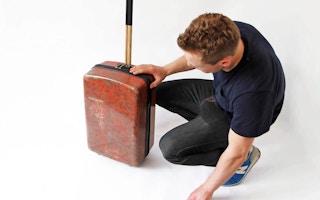New Zealand industrial designer Daniel McLaughlin has developed a sustainable suitcase made from discarded wool and bio-resin, providing business travellers with an eco-friendly luggage while offering hard-knocked farmers added value to their supply chain.
McLaughlin was recently awarded £5,000 by the international James Dyson Foundation for his prototype creation. The organisation, which is dedicated to design and engineering causes, recognised the potential of his creation at the Royal College of Arts (RCA) show in London, where McLaughlin was one of the graduates in the thesis project exhibit.
The hard-case luggage called Terracase combines wool from old carpets together with bio-resin sourced from rapeseed oil. McLaughlin explored the properties of these materials and developed a novel way of manufacturing that combined them to create a durable and green consumer product.
In the designer statements for the RCA show, he said his inspiration for the project came from his native country’s agriculture industry. According to him, farming for wool has experienced volatile prices through the years and ‘biowool’ is his way of enhancing the value of coarse wool.
He explained: “Through the exploration into the wool value chain, high volumes of post-industrial and post-consumer waste were identified as a space for potential innovation – extending the applicability and longevity of a woollen product before it eventually becomes composted as part of the eco-cycle.”
Wool is a renewable fibre, according to the Wools of New Zealand, a high-end brand of quality rugs and carpets. It is produced all year round by sheep farmers and can be disposed naturally under the right conditions. Compared to nylon, wool is more energy efficient, requiring only one-eighth of the energy used to produce nylon.
The Campaign for Wool, a global initiative backed by the Prince of Wales, also espouses the environmental advantages of wool.
Currently, wool waste typically goes to insulation manufacturers due to the material’s good thermal properties. However, it is considered as a ‘downcycled’ resource or waste that has been turned into a new product, albeit of lesser quality and functionality.
For McLaughlin’s design, this is not the case. His biowool composite ‘upcycles’, or increases the value of the discarded wool from old carpets. The material is not only strong, but also biodegradable. He used CAD or computer-aided design technology to create Terracase and conducted finite element analysis (FEA) to test its durability, subjecting it to various drop and handling scenarios.
Steven Parsons, market development and innovation manager at Wools of New Zealand, said in his blog, “We could see the potential for hundreds of applications for Daniel’s work and offered to assist with sourcing re-claimed fibre from the textile industry.”
“This is the beginning of a whole new era for innovation with wool. By moving into new product categories where there are no preconceived ideas about how wool is used and what it’s value might be, we can start imagining the customer experience and design far more exciting products,” he added.

















